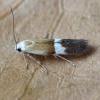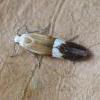35.009 Aproaerema polychromella (Rebel, 1902)
Status and Distribution
A rare migrant occuring mainly in southern and eastern England and southern Ireland, usually in coastal or near coastal localities.
The earliest known records, both in February, in 1952 (Bexley, Kent) and 1999 (Chessington, Surrey), were originally thought to be adventive specimens. Although this may be the case, events in December 2015 proved the moth could arrive as a migrant at any time of year when weather conditions and population levels are suitable.
The earliest records were followed by singletons in Dorset (2006), four sightings in three vice counties (Dorset, Hants and Waterford) during 2009 and, prior to the event detailed below, a singleton in Wiltshire in July 2015.
During late 2015 an exceptional immigration of this species took place between the 16th and 29th of December. At least 84 individuals were reported from seventeen southern English vice counties from Norfolk round to Cornwall and as far inland as Hertfordshire and Oxfordshire. A study of the weather patterns pertaining at that time suggested a probable origin of Morroco or northern Algeria.
This species was recorded as new to Wales (in Ceredigion) in June 2019 (Ina Smith pers. comm.) and noted in Malvern, Worcestershire on 29 November 2024.

Provisional map
Foodplant and Larval Feeding Signs
There are no indications to date that the species has attempted to breed in Britain. In Emmet, A. M & Langmaid, J. R., 2002, the author for A. polychromella reported the only foodplant traced at that time was Lotus sessilifolius, not a plant found in the British Isles.
Habitat
Unknown.
Finding the Moth
As a migrant, it is most likely to be encountered at light along coastal and adjacent inland areas of southern and south-east Britain. Timings to date have included May, June, July and December.
Similar Species
Although there are no likely confusion species currently known in Britain, it should be borne in mind that there is at least one European species (Syncopacma captivella*) which is superficially similar but in which the white fascia is narrower and parallell sided.
*It is not known, in line with British Syncopacma, if S. captivella is now to be known as Aproaerema captivella.
The moth has appeared, twice as a possible adventive, in February, and five times between 2006 and 2009 as a migrant, in May and June. During 2015 it occured once in July and then again in large numbers in December, as migrants, into southern parts of the British Isles.



_0.jpg)